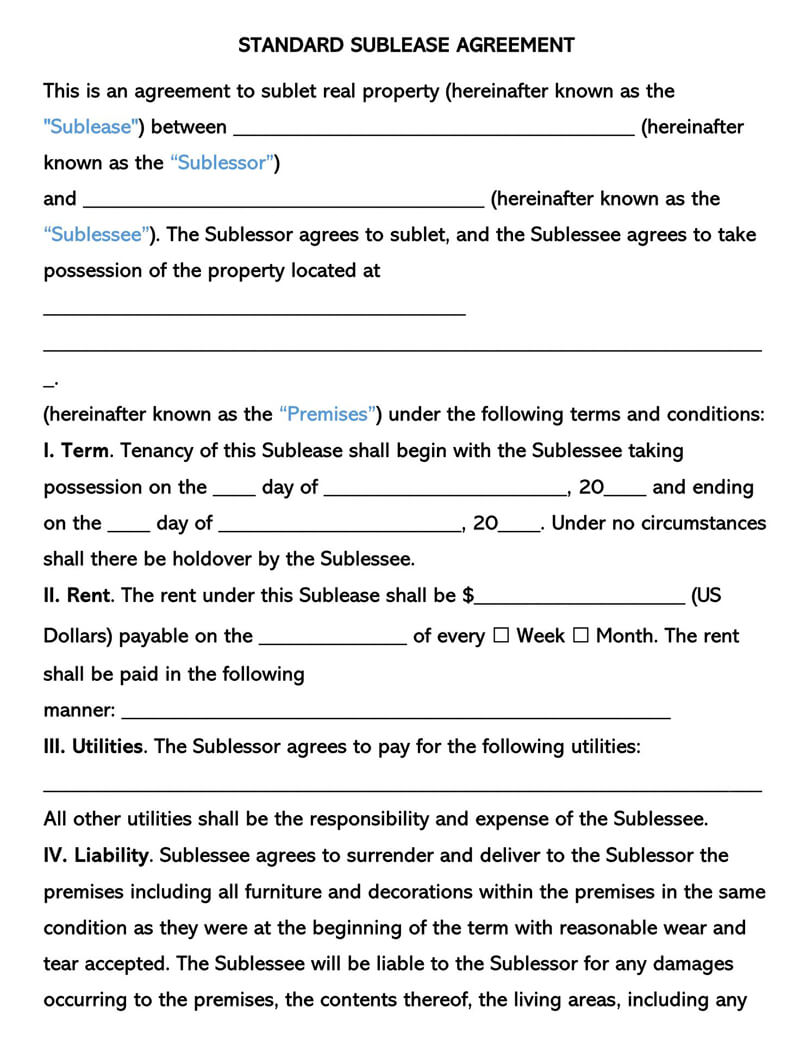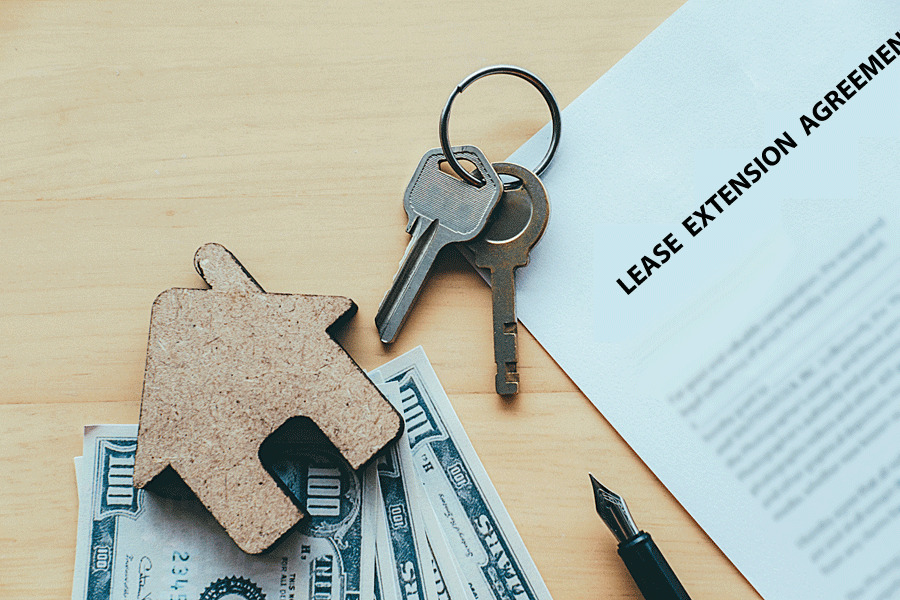Individuals use a commercial sublease agreement , businesses, or corporations who are tenants, to sublease their current rental space to a new tenant without breaking the lease with their landlord. For a sublease to work, the landlord or property owner must have approved it in the rental lease agreement. The landlord may place limitations on who a tenant can re-rent to and the amount of rent they may charge.
A sublease agreement is an additional contract that gives the tenant the freedom to lease out whole or portions of the rented property to a third party.
The subtenant can take residency for the rest of the lease term or whatever period they have agreed with the Tenant, their sublandlord. Depending on the agreement, they may occupy the entire property or simply a portion of it. The subtenant makes their rental payments to the Tenant.
Free Sublease Agreement Templates
Following are the free customizable templates to download for direct usage. You can download these by selecting your state of residence.
By State
Free Standard Template
Provided below is an additional standard sublease agreement template that highlights all the essential components required in it. You can access it with ease by simply clicking download below.

Reasons to Sublease
This agreement contains information about the original lease, the landlord’s consent, financial obligations, and any additional terms relevant to both the Tenant and their subtenant.
The Tenant may decide to sublease their rental property for various reasons that suit their best interests. These reasons may include:
Reduce the office space
If a tenant’s rental space is ample and a portion of it is not in use, subleasing may be a viable option for them for the remaining term. Space can range from a part of the open floor space to an entire empty floor.
When the Tenant is facing an unused open floor space, they may incur additional construction costs to separate the area or opt to share it as is. The Tenant’s goal should dictate how they choose to market the portion of the property they hope to re-rent to a subtenant.
If the Tenant wants to completely vacate the space because they are no longer in need of it or are moving to a new one, they can sublease the entire space. This approach is best when the space is minimal, or they need a different one.
Have more than need
Subleasing is great for high-growth companies. It relieves them of the stress of relocating every time they grow. They can rent out an ample space that will eventually become their home for years.
Organizations and startups that anticipate future growth can lease their larger spaces more than they currently need. They should ensure they look into their growth projections before engaging in a short-term lease with a subtenant. Doing this can save them money and keep them operational until the time comes to take the space back and continue their lease.
Outgrown the current space
Startups and other high growth rate businesses are rapidly growing and are constantly running out of the spaces they occupy. This makes the need to sublease their space necessary to move into a larger space for effective operations.
The choice to either lease additional space or sublease the current office space and move out can be a difficult one to make. On the one hand, renting additional space in an entirely different location can create a divide in the company. It can shift the office culture and create workflow issues and communication problems. This also leads to additional costs in terms of rent, and the company or organization is left with extra unnecessary space.
Subleasing the current space and moving into a larger, more appropriately sizable one can save money for the company or business in the long run.
Transferring or shutting down
If a company or business is moving elsewhere or is forced to shut down before the end of the lease term, subleasing could save them from paying double rent or paying for an empty, unused space. This will help prevent them from paying a hefty termination penalty imposed by the landlord for early termination.
Seasonal business
If a company or business has a long-term lease but expects seasonal business, subleasing can help them cut costs during the off-season. This will ensure they are not constantly bleeding money when business is not at its peak.
Work with consultant
Work with consultants or contractors is regarded as a temporary relationship. If a tenant has a long-term lease, they may sublet their space to these consultants or contractors for the duration of their work together to ensure smooth communication and workflow. This is especially the case when the business or individual they are working with is based online or works from home. As such, they have no definite official workspace.
Understanding Sublease Agreement
It is essential to have a deep and clear understanding of this agreement. A typical commercial lease agreement entails the following:
Involved parties
Involved parties are the parties that play a significant role when formulating the agreement of commercial sublease. The involved parties are the individuals who dictate the rules and provisions of the agreement. The parties are responsible for setting out the terms and conditions of the agreement.They include:
- Landlord: A landlord or property owner is responsible for managing a rental property or has ownership over it. The landlord signs the lease over to the Tenant, and therefore, the sublease agreement requires their permission.
- Tenant/sublandlord: A tenant is an individual or organization that initially leases the property from the landlord. A tenant who subleases their space is known as a sublandlord and is still answerable to the landlord because they are held by the terms of the original lease agreement.
note
As the sublandlord, the Tenant is responsible for any damages caused by their subtenant.
- Subtenant: A subtenant is an individual who rents space or property from the sublandlord. He/she exclusively make rent payments and reports any property issues to the sublandlord.
Tenant’s responsibility
The Tenant is required to ensure the master lease with their landlord permits subleasing. They must then seek to notify the landlord of their intention to sublease and acquire written permission.
If the Tenant is prohibited from subleasing, or it is not mentioned in the master lease, a Landlord’s Consent to Sublease must be obtained. This will ensure they do not violate the terms of the rental lease agreement and the landlord is aware of their intent to sublet.
Apart from that, when deciding to sublease a property, the tenant must be aware that any damages of property caused by the subtenant are his/her responsibility. Being aware of this responsibility prompts the tenant to develop provisions in the agreement that state the consequences of causing damages to the property. However, this right to seek compensation for damages from the subtenant does not exempt the tenant from the ultimate responsibility for the property as per the initial lease.
Elements of the sublease agreement
The agreement must contain certain elements to guarantee effectiveness and enforceability. Elements of the agreement are:
- The date of the agreement: The date of the agreement refers to when the agreement was signed and when the agreement is expected to come into effect.
- The names and addresses of both the sublandlord and their subtenant: The commercial sublease agreement should identify the Tenant and subtenant who are making the agreement by name and address to illustrate precisely who is bound by the agreement.
- The property’s physical location or space: The property’s location should be described in the sublease agreement by providing the property’s street address.
- Term period: The sublessor and sublessee will often have an agreed sublease term which illustrates the duration of time within which the agreement will be valid. This duration should be declared in the agreement.
- The rent due date: Landlords will often have a date of preference when they want their tenants to pay rent. The sublessee will often be subjected to the same date, and it should be indicated in the agreement.
- Monthly rent amount: The amount of money the subtenant is expected to pay every month should be declared in the agreement of commercial sublease .
- Security deposit, late fees, and penalties incurred: Security deposit refers to the amount of money that the subtenant is expected to pay as a gesture of good faith and commitment. The exact amount (usually a few months’ worths of rent) should be stated in the agreement. Sometimes tenants will fail to make rent payments on time; the agreement should outline the actions the tenant/sublessor will take in the event of late rent payment, a returned payment, etc., which will often involve penalties.
- The acceptable forms of payment: Different sublessors have different preferences when it comes to the avenues of payment the subtenant may use to pay rent; standard payment methods include pay pal, credit card, cash, check, etc. the specific preferred method should be specified.
- The Responsibilities of all parties for services, maintenance, and utilities: The agreement of commercial sublease should outline the designated responsibilities of the Tenant and subtenant when it comes to matters utilities, services, and maintenance operations.
- Contract termination grounds: Any activity or action that can lead to the termination of the sublease contract should be listed. Such grounds include breach of contract, house policies, etc. The agreement should outline the expenses the subtenant will incur, their payment responsibility, and any potential legal action the tenant/sublessor will take for failure to meet the contractual terms.
- Communal or shared space provisions: Commercial property will often have common or shared areas. This agreement should outline who between the Tenant and the subtenant is responsible for the care and maintenance of the common areas.
- Policies on parking and visitors: The agreement should declare any policies regarding parking and visitation the subtenant is expected to observe, for example, parking fees and allocated parking spaces.
- Emergency and eviction procedures: The agreement ought to outline any procedures the subtenant can follow in the event of an emergency. The agreement will also state the process the subtenant will follow in the event of an eviction.
- Insurance requirements: In most cases, when subleasing commercial property, a subtenant will need to apply for insurance to cover particular aspects of the business. Therefore, sublessors often request the subtenant to meet these insurance requirements before signing an agreement of commercial sublease.
- Acceptable use of premises: The sublease agreement will commonly showcase the type of business activities the Tenant can carry out on the property.
Subleasing the Property
If a tenant decides to sublease their rental property, they must be aware of the steps they need to take to ensure the legitimacy of the process. The Tenant must always keep in mind that they are still responsible for the property and answerable to the landlord. The Tenant should:
Read the initial commercial lease
A full review of the initial commercial lease can reveal the landlord’s prohibition over subletting the space occupied by the Tenant. Getting the landlord to approve a consent form can help get the subleasing process off the ground.
When the initial commercial lease states that the landlord allows subleasing of their property, the Tenant is expected to find out any conditions to be met before acquiring a written approval from the landlord
- Landlord Sublease Consent Form: The rules that govern the sub-lease of a piece of real estate to a third party are all captured in the landlord sub-lease consent form. This form spells out the way in which the property concerned shall be given out to a third party.
It also states categorically that the original tenant bears the full responsibility for any damages that arise in the period of occupancy of the said piece of property. These include non-payment of rent, property damages, and any other liabilities that may arise during the use of the property.
Sublease the property
Once the Tenant can sublease, they should consider marketing the property if they don’t already have the subtenant on standby. The Tenant can make an online posting or hire a commercial subleasing agent. Using an excellent local agent with market knowledge is likely to increase their chances of finding a suitable subtenant.
Discuss with the subtenant
The Tenant should shortlist the individuals or organizations they feel meet the requirements they are looking for. The Tenant’s primary objectives should be to get as much rent as possible and ensure the potential subtenant can pay it. The information they obtain requires they conduct:
- Background check: Conducting a background check reassures the Tenant of the candidate’s credit scores and criminal history. Using the background check consent, the Tenant ensures they do not violate the potential subtenant’s rights.
- Tax returns: The Tenant should obtain the subtenant’s last two-year tax returns, including the individual and corporate filings.
If the Tenant is satisfied and decides to approve the candidate as a subtenant, they may begin discussing and outlining the rental agreement.
Generate a sublease agreement
At this stage of the process, the Tenant and subtenant can sit down and create a sublease agreement that is suitable to their needs. This should be done keeping in consideration the components of agreement enlisted above already in this article. Note that the agreement cannot exceed the end date of the initial lease. The Tenant may require the landlord to sign the agreement.
- Obtain written consent from your landlord: Remember, you are not the owner of the property. It still remains that of the landlord for all practical purposes. That is why you have to obtain a special written consent of the property owner before going ahead to sub-let it to a third party.
- Clearly identify all Parties to the Deal: Clearly identify all the parties to the deal. These are definitely you, the landlord, and the tenant who shall take over part of your premise when you are away. In case there are many tenants, consider designating one to be the ‘master tenant.’ This is the person who shall collect the rental revenue and bear any responsibilities for losses or damages.
- List the Dates of the Sub-lease Agreement: List now the dates of the sub-lease agreement. These are the dates when the lease shall start and end. It also incorporates the total sum duration of time that the agreement shall be in force. By clarifying the dates, you will leave no room for misunderstandings.
- Clarify all the costs aspects involved: Obviously, some money will have to be paid in the course of implementing the provisions of the sub-lease agreement. These include the security deposit, rental payments, taxes, and any utility bills that are involved in the process of maintaining the rental agreement.
- State how any emerging disputes may be settled: It is not uncommon for disputes to arise in the course of occupancy. That is why it is a wise idea to state exactly how you intend that the emerging issues shall be sorted out. An out-of-court settlement is by far the best way to go about the issue. That is because it is cheaper and takes limited also to implement.
- Sign the Lease: After you are through with filling every blank space of the agreement, you should now go ahead and sign it. Have the other parties to the deal also append their signatures. Make several copies and have each party served with a photocopy of the deal.
Start of the sublease
The Tenant and their subtenant are expected to sign the sublease agreement once they both feel satisfied with its terms and conditions. The Tenant must then turn over space to the subtenant by the lease start date. Payment of the security deposit and the first month’s rent must take place before the subtenant move in. The subtenant’s daily operations can begin without interruption until the end of the lease term.
End of lease term
Without signing a lease renewal, the subtenant will be required to move out of the space at the end of the lease term. If the subtenant desires to stay the Tenant’s lease yet has ended, discussions between the landlord and the subtenant can occur to negotiate a new rental lease agreement.
It is the Tenant’s responsibility to ensure the property has not sustained any damage during the subtenant’s stay.
Frequently Asked Questions
A tenant must first confirm whether or not they are permitted to sublease from their master lease with the landlord. The Tenant must then notify the landlord of their intent to sublet the property to acquire permission in writing. If there is no mention of subleasing in the master lease or prohibited, they can obtain a Landlord’s Consent to Sublease.
A tenant may have various reasons to sublease their property. These reasons may range from having an ample unused vacant space, having more room than they need, outgrowing their current space, and relocation or shutdown of their company or organization. Subleasing may enable a tenant to save money by find use for their unused rental space.
The commercial lease agreement is concluded at the lease term as stated in the rental agreement. It may also end following the lease period the Tenant and their subtenant have worked out. Violation of the sublease may result in the subtenant’s eviction depending on the stipulated terms and conditions, therefore ending the sublease agreement.











